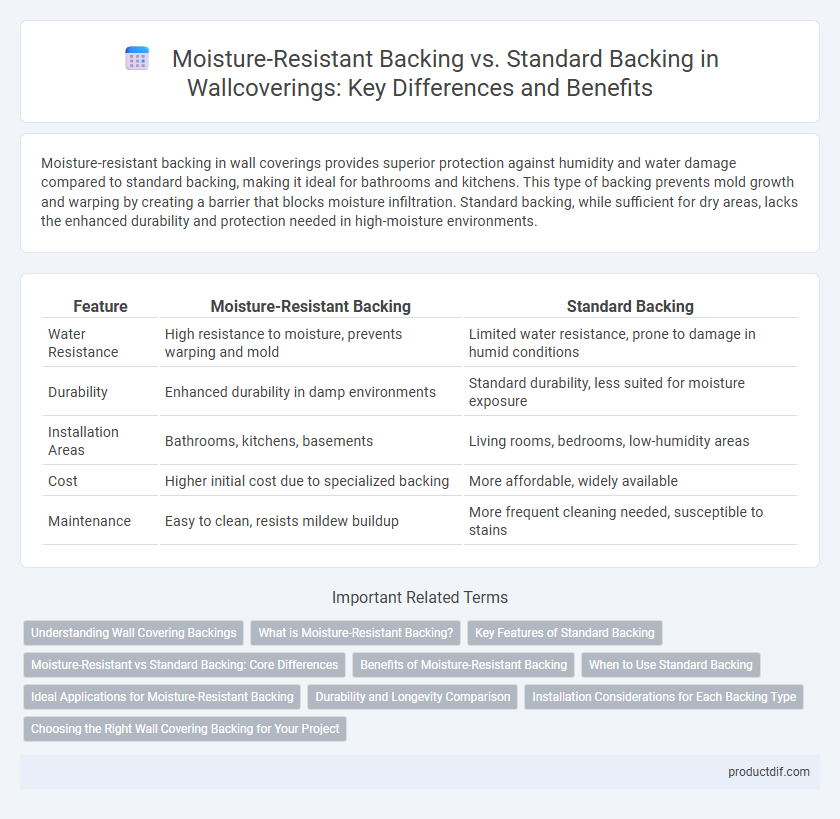Moisture-resistant backing in wall coverings provides superior protection against humidity and water damage compared to standard backing, making it ideal for bathrooms and kitchens. This type of backing prevents mold growth and warping by creating a barrier that blocks moisture infiltration. Standard backing, while sufficient for dry areas, lacks the enhanced durability and protection needed in high-moisture environments.
Table of Comparison
| Feature | Moisture-Resistant Backing | Standard Backing |
|---|---|---|
| Water Resistance | High resistance to moisture, prevents warping and mold | Limited water resistance, prone to damage in humid conditions |
| Durability | Enhanced durability in damp environments | Standard durability, less suited for moisture exposure |
| Installation Areas | Bathrooms, kitchens, basements | Living rooms, bedrooms, low-humidity areas |
| Cost | Higher initial cost due to specialized backing | More affordable, widely available |
| Maintenance | Easy to clean, resists mildew buildup | More frequent cleaning needed, susceptible to stains |
Understanding Wall Covering Backings
Moisture-resistant backing in wall coverings significantly enhances durability by preventing water damage, mold growth, and peeling, making it ideal for high-humidity areas like bathrooms and kitchens. Standard backing provides basic structural support but lacks protection against moisture infiltration, which can lead to premature wear and reduced lifespan of the wall covering. Choosing the right backing improves wall covering performance and ensures long-term aesthetic appeal and maintenance ease.
What is Moisture-Resistant Backing?
Moisture-resistant backing is a specialized layer applied to wall coverings designed to prevent water absorption and resist humidity damage, making it ideal for bathrooms and kitchens. Unlike standard backing, which may allow moisture penetration leading to mold and peeling, moisture-resistant backing provides enhanced durability and longevity. This technology helps maintain the adhesive strength of the wallpaper and preserves the integrity of the wall surface in high-moisture environments.
Key Features of Standard Backing
Standard backing in wall coverings offers dependable durability and ease of installation, typically composed of non-woven or paper materials. It provides adequate support for a variety of indoor environments but lacks moisture resistance, which can limit its use in high-humidity areas. This backing is ideal for living rooms and bedrooms where moisture exposure is minimal and cost-efficiency is a priority.
Moisture-Resistant vs Standard Backing: Core Differences
Moisture-resistant backing in wall coverings incorporates specialized materials like vinyl or polyethylene layers to prevent water absorption and withstand humid environments, unlike standard backing which typically uses paper or fabric prone to moisture damage. This moisture-resistant feature enhances durability, reduces the risk of mold growth, and extends the lifespan of the wall covering in bathrooms, kitchens, or basements. Standard backing lacks these protective properties, making it more susceptible to peeling, warping, and adhesive failure under high humidity conditions.
Benefits of Moisture-Resistant Backing
Moisture-resistant backing in wall coverings significantly prevents mold, mildew, and damage caused by humidity, making it ideal for bathrooms and kitchens. This backing enhances durability and longevity, reducing the need for frequent repairs or replacements. Unlike standard backing, moisture-resistant options provide a protective barrier that maintains the aesthetic and structural integrity of walls in damp environments.
When to Use Standard Backing
Standard backing is ideal for dry, low-humidity environments where moisture exposure is minimal, such as living rooms or bedrooms. It provides adequate durability and adhesion for typical indoor conditions without the added cost of moisture resistance. Choosing standard backing ensures optimal performance in well-ventilated areas with stable moisture levels.
Ideal Applications for Moisture-Resistant Backing
Moisture-resistant backing is ideal for high-humidity environments such as bathrooms, kitchens, and basements where standard backing may deteriorate or peel. This specialized backing prevents mold growth and maintains adhesion on walls exposed to moisture, ensuring durability and longevity. Using moisture-resistant wall coverings in these applications enhances both aesthetic appeal and structural integrity in challenging conditions.
Durability and Longevity Comparison
Moisture-resistant backing enhances wall covering durability by preventing water damage and mold growth, significantly extending the lifespan compared to standard backing. Standard backing is prone to warping and deterioration in humid environments, reducing its longevity. Choosing moisture-resistant backing ensures a more resilient surface suitable for bathrooms and kitchens where moisture exposure is frequent.
Installation Considerations for Each Backing Type
Moisture-resistant backing requires installation in environments with higher humidity or potential water exposure, ensuring durability and preventing mold growth, while standard backing is suitable for dry, controlled indoor spaces. Proper adhesive selection is crucial for moisture-resistant wall coverings to maintain adhesion over time, whereas standard backing allows for a wider range of adhesive options. Installation of moisture-resistant backing may involve additional sealing or priming steps to enhance moisture protection, unlike standard backing that typically follows straightforward application procedures.
Choosing the Right Wall Covering Backing for Your Project
Moisture-resistant backing in wall coverings provides superior protection against humidity and dampness, making it ideal for bathrooms, kitchens, and basements where moisture exposure is high. Standard backing suits low-moisture environments like living rooms and bedrooms due to its affordability and ease of installation. Selecting the right backing hinges on assessing room conditions and moisture levels to ensure durability, prevent mold growth, and maintain aesthetic appeal over time.
Moisture-Resistant Backing vs Standard Backing Infographic

 productdif.com
productdif.com